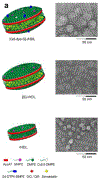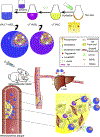Surface-modified nanotherapeutics targeting atherosclerosis
- PMID: 35980230
- PMCID: PMC9529904
- DOI: 10.1039/d2bm00660j
Surface-modified nanotherapeutics targeting atherosclerosis
Abstract
Atherosclerosis is a chronic and metabolic-related disease that is a serious threat to human health. Currently available diagnostic and therapeutic measures for atherosclerosis lack adequate efficiency which requires promising alternative approaches. Nanotechnology-based nano-delivery systems allow for new perspectives for atherosclerosis therapy. Surface-modified nanoparticles could achieve highly effective therapeutic effects by binding to specific receptors that are abnormally overexpressed in atherosclerosis, with less adverse effects on non-target tissues. The main purpose of this review is to summarize the research progress and design ideas to target atherosclerosis using a variety of ligand-modified nanoparticle systems, discuss the shortcomings of current vector design, and look at future development directions. We hope that this review will provide novel research strategies for the design and development of nanotherapeutics targeting atherosclerosis.
Conflict of interest statement
Disclosure
The authors report no conflicts of interest in this work.
Figures






References
Publication types
MeSH terms
Substances
Grants and funding
LinkOut - more resources
Full Text Sources
Medical

